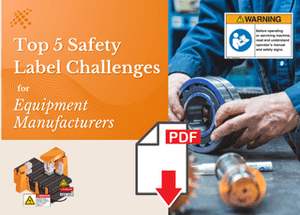New Agricultural Technologies Call for New LOTO Procedures

Over the past several years, the agricultural industry has faced growing labor shortages, and many employers site the reason being that they are having to compete with jobs offering higher pay and less physical demands. This trend has actually started to result in a push for more automation and the retraining and rehiring of new workers that can use advanced equipment. Increased use of automation requires a further look into safety procedures that deal with lockout/tagout procedures, and ensuring that employers are remembering to properly train their workers on best practices when using equipment.
To provide industry-specific feedback, we were able to consult with the American Feed Industry Association’s (AFIA) Director of Feed Manufacturing and Regulatory Affairs, Gary Huddleston.
Combatting the Agricultural
Labor Shortage
When asked about the driving factors contributing to the labor shortage and
uptick in automation in agriculture and feed manufacturing, Gary noted how the
shortage is effecting all industries – not just agriculture – but also how
automation factors in. “Our industry has been moving toward more
automation in manufacturing for quite a while now. This has been driven largely
by two factors – 1) the need to control labor costs; 2) the need for more
consistent quality. The recent labor shortage has certainly added a third layer
and is accelerating industry facilities’ move toward more automation. We have
seen an increase in the use of more robotics in our industry, especially on the
packaging side, so that has changed the dynamics of the typical workforce a
bit.”
The following strategies are being implemented across the nation to solve the labor and production shortages, and with them will come an increased demand for safety as the complexity of equipment and tasks shifts.
1. Widespread integration of agricultural technology to reduce physical burdens and repeated stress injuries on current workers.
2. Placing holds on land expansions and reinvesting into new technologies like wireless sensors, automation, predictive forecasting, robotics, and data analytics.
3. Utilizing different crops that are easier to manage and therefore require less workers, and some crops are not compatible with automatized equipment yet.
4. Hiring workers with different skillsets that require them to interact with automation and human machine interface systems.
Preventing Injuries with
Automation
Even
when workers are trained in proper handling techniques, accidents can still
happen which can result in musculoskeletal related injuries, primarily from
overexertion or repetitive motion. The developments of new machinery and
automated tasks have helped decrease repetitive motion and other ergonomic
injuries across not only agriculture, but every physically demanding profession
as well.
Gary was able to shed more light on the initial benefits of automation in the feed industry. “This first took hold in our industry in the batching area of the plants. Automated batching systems and micro-ingredient addition systems not only improved quality, but decreased some of the manual handling of ingredients.”
“The use of robotics in the packaging area is becoming more common today as well,” he explains, “as some of the most common injuries in feed manufacturing were back injuries in the packaging area. As facilities began to use more robotics in packaging to eliminate the need for manual stacking and handling, back injuries decreased.”
According to the Bureau of Labor Statistics, back injuries accounted for 38.5% of all musculoskeletal incidents at work in 2016.
Robotics in the workplace is only getting more popular, with sales in 2020 rising 63.9 percent over 2019. The ability to handle and move dangerous or heavy materials relieves employees from the most labor intensive parts of their jobs which reduces injuries and turnover rates due to higher employee satisfaction and lessened fatigue.
A LOTO Program to
Accommodate New Technologies
Proper
lockout/tagout (LOTO) practices and procedures safeguard workers from the
release of hazardous energy. The OSHA standard for The Control of Hazardous
Energy (Lockout/Tagout) (29 CFR 1910.147) for
general industry, outlines the specific actions and procedures for addressing
and controlling hazardous energy during servicing and maintenance of machines
and equipment.
The Lockout/Tagout Standard from OSHA hasn’t been updated in a while. In fact, it was published in 1989, and while OSHA has announced plans to update other regulatory standards like their powered industrial trucks, we have yet to see new LOTO rules. OSHA did take comments from the industry on potentially updating the standard back in 2019, and it was listed on their official agenda in the fall of 2021 in the proposed rule stage. Still, it doesn’t seem that the timeline has been prioritized yet.
When asked about the changes he would like to see in the LOTO standards, Gary hopes that OSHA will recognize the recent technological advances that have improved the safety of control circuit-type devices and computer based controls whenever the new update comes. He also expects OSHA to consider changes to the standard that address hazardous energy control for new robotics technologies, although he is doubtful about expecting to see any updates to the LOTO standard in 2022.
Interestingly enough, small farms are actually exempt from the LOTO standard for general industry, but are still required to follow the OSHA general duty clause in section 5(a)(1) which requires employers to provide a workplace free of recognized hazards that are likely to cause death or serious harm. This has resulted in most agricultural operations still following the industry general requirements, but it would be interesting to see if industry specific rules were made in the future.
How to Train Employees on
LOTO Procedures
Employers
are required to train each worker to ensure that they know, understand, and are
able to follow the applicable provisions of the hazardous energy control
procedures. Workers must be trained in the purpose and function of the energy
control program and have the knowledge and skills required for the safe
application, usage, and removal of energy control devices.
When asked about the best way to educate employees on LOTO procedures, Gary responded that, “There is no substitute for solid annual training. All employees should be trained on LOTO procedures, but maintenance employees need more extensive and detailed training.”
All employees who work in an area where energy control procedures are utilized need to be instructed in the purpose and use of those energy control steps, especially prohibition against attempting to restart or reenergize machines or other equipment that are locked or tagged out.
Gary points out here that the best way to do this is by having a detailed written LOTO program that includes a comprehensive list of all equipment in the facility with specific instructions for every piece of equipment on how to lockout all potential energy sources. “A solid written LOTO program that includes detailed instructions for every piece of equipment makes training employees much easier. It removes the guesswork and definitely prevents injuries,” he says.
Build and Maintain Your
Safety Program
Not having a lockout/tagout
program in place within your facility counts as a willful violation that
intentionally breaches OSHA standards. This also includes not having an
accessible procedure or placard for each piece of relevant equipment or
improper training. These can be fined up to $70,000 if no injuries or deaths
occur and if an employee is injured or killed due to a willful violation, your
company can face criminal charges and a fine of $250,000.
At Clarion Safety, we make it our priority to help make sure that you’re staying up to date with the latest workplace safety issues, as well as the current standards and best practices for visual safety communication related to your equipment and facilities. Browse our comprehensive collections of safety labels and signs that cover automatic startups and LOTO instructions, or manage your own training program with our ClarionAccess® platform. Questions? Reach out to our team today!



